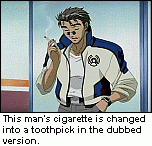
R emula Wazokana watched yet another butchered
episode of Dragon Ball Z. From the first few episodes of the series, she
knew the show would become another "Sailor Moon" -- popular, but edited
beyond belief. Now, years later, her theory proved correct. Censorship was still at
large.
Censorship is not something new to the world.
It happens everywhere. On the radio, you could be listening to a song, and right in the
middle you hear a cut or beep. That's what censorship is: editing or suppressing
content that is "questionable". In Japanese animation, also known as anime, censorship
happens all the time.
Anime has a very bad reputation because of its
stereotype of having either "big breasted women" or "giant robots". As for others who
are unfamiliar with the term "anime", they usually associate it with the very popular and
Americanized versions of Sailor Moon, Dragon Ball Z,
and Pokémon once they know the meaning. This also gives anime a bad
reputation because the dubbed versions are heavily edited and censored, changing the
original intent of the show.
The things edited or censored in an anime depends
on the company doing the dubbing. However the changes are usually the same.
Generally you'll find that nudity is digitally covered (usually with a bathing suit), most sexual
comments and scenes will be cut or changed, blood is erased (although they do show
some on the popular animes), and profanity is changed into
less harsh words (e.g. darn, heck, blast). Also items such as cigarettes are changed
or edited to other things and, most of the time, the Japanese culture is cut out.
Sometimes, if these items are essential to the plot, the storyline is harder to follow.
Isn't Censorship Good?
In most parents' opinion, censorship is needed.
Because anime is so popular nowadays, they believe that it protects the children from
language, violence, and other themes anime produces. Without the exposure of these
things, supporters believe minors will not be influenced into doing the wrong things.
"What they don't see, they don't know, and what they don't know can't hurt or influence
them," says Tippy Cung, an anime fan who is advocates censorship in moderation.
While censorship can protect children from the
"morally corrupt", it is not the television station's job to protect the children. Parents are
partly to blame for not monitoring what their children are watching. Because anime is
animated, parents just assume that it is suitable for kids, but that is not always the case.
Anime is not geared solely for children, but for people of all ages, which is why there are
many themes that Americans consider "taboo". Like anime fan D. Sanders, also known
as The Fablespinner, said, "If you can't handle the WHOLE truth, do not edit stories you
didn't write. Just don't show it if it offends you."

Melinda Jansson, an anime fan in Sweden, says
that "A story is like a knitted jumper. Every stitch is intimately connected to all the other
stitches that make up the jumper. If you take away a stitch, the rest of the jumper slowly
gets destroyed. You can only take away stitches when you're making it, but once you're
finished with the jumper you can't take away stitches -- or add for that matter. If you
censor a story you're taking away the stitches and the jumper gets destroyed." Many fans
probably agree with this sentiment.
Out of 50 people surveyed, only 4% agree with
censorship in anime. About 16% say they agree with censorship in moderation while
the other 80% disagree with anime censorship strongly.
The Cover Up
Some people think that not much changes when an
anime is censored. This is not always the case. Scenes edited out or dialogue changes
can cause many actions a character does to be questionable. For some animes, like the
English version of Yu-Gi-Oh!, the whole plot changes.
Sailor Moon is a great example of what
censorship can do. The anime, originally made for a teenage audience, was censored
down into a